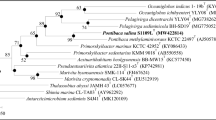Abstract
The Gram-stain-negative, rod-shaped and non-motile bacterial strain, designated ZGLJ7-1T, was isolated from a pit mud. Phylogenetic analysis based on 16S rRNA gene sequence showed that strain ZGLJ7-1T was related to the genus Lysobacter and had the highest 16S rRNA gene sequence similarity with the type strain of Lysobacter arseniciresistens ZS79T (97.4%). The predominant cellular fatty acids were iso-C15:0, iso-C17:1ω9c, iso-C11:0 and iso-C11:03-OH. Strain ZGLJ7-1T had Q-8 as the predominant ubiquinone. The polar lipid profile contained diphosphatidylglycerol, phosphatidylglycerol, phosphatidylethanolamine, one unidentified phospholipid, two unidentified aminolipids and two unidentified lipids. The genomic DNA G+C content of strain ZGLJ7-1T was 69.5 mol%. Strain ZGLJ7-1T shared DNA relatedness with 35% Lysobacter arseniciresistens CGMCC 1.10752T. Combined data from phenotypic, phylogenetic and DNA–DNA relatedness studies demonstrated that the strain ZGLJ7-1T is a representative of a novel species of the genus Lysobacter, for which we propose the name Lysobacter zhanggongensis sp. nov. (type strain ZGLJ7-1T = KACC 18547T = CGMCC 1.15404T).



Similar content being viewed by others
References
Christensen P, Cook FD (1978) Lysobacter, a new genus of nonfruiting, gliding bacteria with a high base ratio. Int J Syst Bacteriol 28:67–393
Saddler GS, Bradbury JF (2005) Family I. Xanthomonadaceae fam. nov. In: Bergey’s manual of systematic bacteriology, 2nd edn, vol 2. New York: Springer, p 63
Park JH, Kim R, Aslam Z, Jeon CO, Chung YR (2008) Lysobacter capsici sp. nov., with antimicrobial activity, isolated from the rhizosphere of pepper, and emended description of the genus Lysobacter. Int J Syst Evol Microbiol 58:387–392
Choi JH, Seok JH, Cha JH et al (2014) Lysobacter panacisoli sp. nov., isolated from ginseng soil. Int J Syst Evol Microbiol 64:2193–2197
Fukuda W, Kimura T, Araki S et al (2013) Lysobacter oligotrophicus sp. nov., isolated from an Antarctic freshwater lake in Antarctica. Int J Syst Evol Microbiol 63:3313–3318
Luo G, Shi Z, Wang G (2012) Lysobacter arseniciresistens sp. nov., an arsenite-resistant bacterium isolated from iron-mined soil. Int J Syst Evol Microbiol 62:1659–1665
Wei DQ, Yu TT, Yao JC et al (2012) Lysobacter thermophilus sp. nov., isolated from a geothermal soil sample in Tengchong, South-West China. Antonie Van Leeuwenhoek 102:643–651
Weon HY, Kim BY, Baek YK et al (2006) Two novel species, Lysobacter daejeonensis sp. nov. and Lysobacter yangpyeongensis sp. nov., isolated from Korean greenhouse soils. Int J Syst Evol Microbiol 56:947–951
Sambrook J, Russell DW (eds) (2001) Molecular cloning: a laboratory manual. Cold Spring Harbor Laboratory Press, Cold Spring Harbor, New York
Zhang DC, Redzic M, Schinner F, Margesin R (2011) Glaciimonas immobilis gen. nov., sp. nov., a member of the family Oxalobacteraceae isolated from alpine glacier cryoconite. Int J Syst Evol Microbiol 61:2186–2190
Kim OS, Cho YJ, Lee K et al (2012) Introducing EzTaxon: a prokaryotic 16S rRNA gene sequence database with phylotypes that represent uncultured species. Int J Syst Evol Microbiol 62:716–721
Tamura K, Stecher G, Peterson D, Filipski A, Kumar S (2013) MEGA6: molecular evolutionary genetics analysis version 6.0. Mol Biol Evo 30:2725–2729
Marmur J, Doty P (1962) Determination of the base composition of deoxyribonucleic acid from its thermal denaturation temperature. J Mol Biol 5:109–118
De Ley J, Cattoir H, Reynaerts A (1970) The quantitative measurement of DNA hybridization from renaturation rates. Eur J Biochem 12:133–142
Huss VAR, Festl H, Schleifer KH (1983) Studies on the spectrometric determination of DNA hybridisation from renaturation rates. Syst Appl Microbiol 4:184–192
Sasser M (1990). Identification of bacteria by gas chromatography of cellular fatty acids. Technical Note 101. Newark, DE: MIDI Inc
Altenburger P, Kämpfer P, Makristathis A, Lubitz W, Busse HJ (1996) Classification of bacteria isolated from a medieval wall painting. J Biotechnol 47:39–52
Stolz A, Busse HJ, Kämpfer P (2007) Pseudomonas knackmussii sp. nov. Int J Syst Evol Microbiol 57:572–576
Bligh EG, Dyer WJ (1959) A rapid method of total lipid extraction and purification. Can J Biochem Physiol 37:911–917
Tindall BJ (1990) Lipid composition of Halobacterium lacusprofundi. FEMS Microbiol Lett 66:199–202
Tindall BJ (1990) A comparative study of the lipid composition of Halobacterium saccharovorum from various sources. Syst Appl Microbiol 13:128–130
Tindall BJ, Sikorski J, Smibert RM, Kreig NR (2007) Phenotypic characterization and the principles of comparative systematics. Methods for general and molecular microbiology, 3rd edn. American Society of Microbiology, Washington, pp 330–393
Saitou N, Nei M (1987) The neighbor-joining method: a new method for reconstructing phylogenetic trees. Mol Biol Evol 4:406–425
Wayne LG, Brenner DJ, Colwell RR (1987) Report of the Ad Hoc committee on reconciliation of approaches to bacterial systematics. Int J Syst Bacteriol 37:463–464
Acknowledgements
This research work was supported by the technology innovation team project and key subject construction from Henan University of Animal Husbandry and Economy.
Author information
Authors and Affiliations
Corresponding author
Ethics declarations
Conflict of interest
The authors declare that they have no conflict of interest.
Electronic Supplementary Material
Below is the link to the electronic supplementary material.
Rights and permissions
About this article
Cite this article
Zhang, XF., Wang, HH., Sun, XY. et al. Lysobacter zhanggongensis sp. nov. Isolated from a Pit Mud. Curr Microbiol 74, 1389–1393 (2017). https://doi.org/10.1007/s00284-017-1330-y
Received:
Accepted:
Published:
Issue Date:
DOI: https://doi.org/10.1007/s00284-017-1330-y




